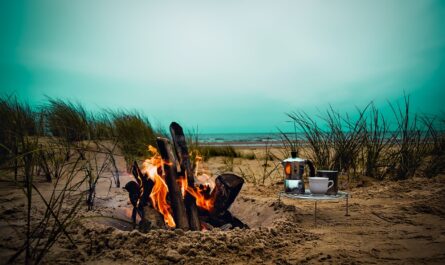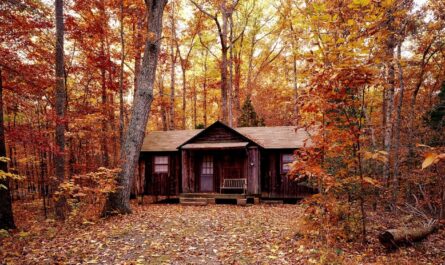Packing food for cabin or cottage camping is essential to trip planning. It can distinguish between a great outdoor adventure and a stressful experience. Properly packed food ensures nutritious meals throughout your trip while minimizing the risks of foodborne illnesses. This guide will walk you through how to pack food for cabin camping, from meal planning to food storage, and provide practical tips for cooking at the campsite. Whether preparing for a weekend trip or a multi-day stay, these strategies will help you pack the right foods, keep them fresh, and enjoy delicious meals in the great outdoors.
Table of Contents For How to Pack Food for Cabin Camping
Why is Meal Planning Important for Cabin or Cottage Camping?
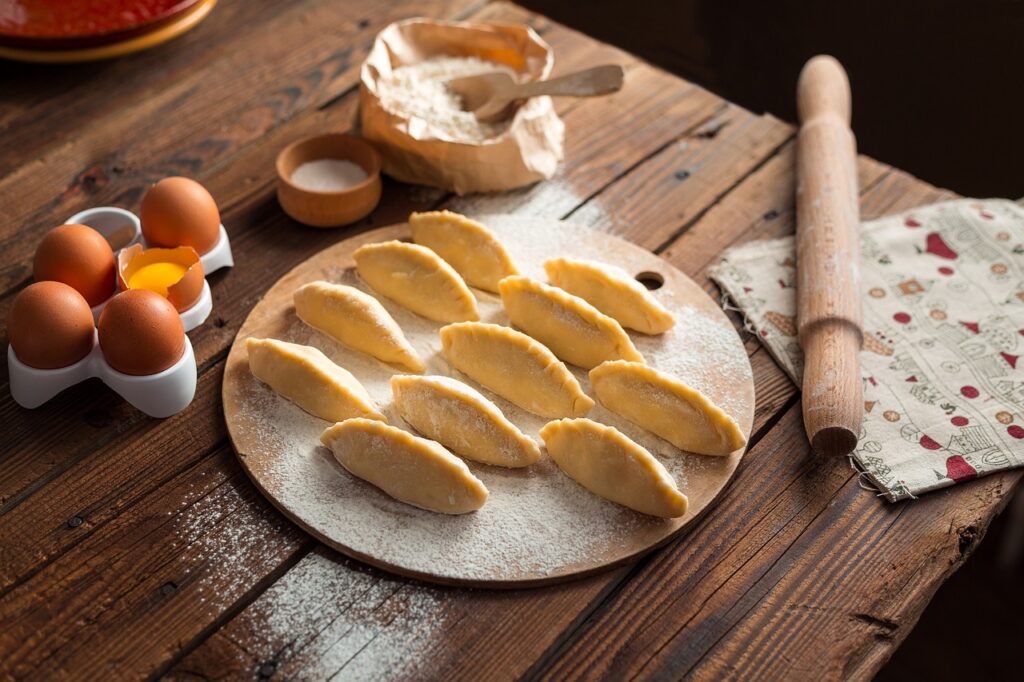
Meal planning is a crucial step in preparing for a cabin or cottage camping trip. It ensures you bring enough food to sustain you and your fellow campers without overpacking and wasting space. Here are some reasons why meal planning is a good idea:
- Ensures Enough Food: Proper planning helps you pack the right amount of food for the duration of your trip. This is especially important for longer trips with limited access to grocery stores.
- Accommodates Dietary Needs: Meal planning allows you to consider everyone’s dietary preferences and restrictions. You can pack various food items catering to different tastes and nutritional needs, ensuring everyone enjoys nutritious meals.
- Minimizes Waste: By planning your meals, you can avoid overpacking and reduce food waste. This is environmentally friendly and helps manage the limited space available in your coolers and storage containers.
- Simplifies Camp Cooking: With a meal plan, you know exactly what you’ll be cooking each day. This eliminates the guesswork and makes camp cooking more efficient. Preparing make-ahead meals and using easy-to-cook ingredients like pasta sauces and pancake mix can save you a lot of time at the cabin or cottage.
- Adapts to Different Types of Camping: Whether you’re car camping, embarking on a multi-day stay, or spending a weekend at a national park, meal planning helps you tailor your food packing to suit the specific needs of your trip.
Taking the time to plan your meals before your next cabin or cottage camping trip can go a long way in ensuring a smooth and enjoyable experience.
What Types of Food Should You Pack for Cabin or Cottage Camping?
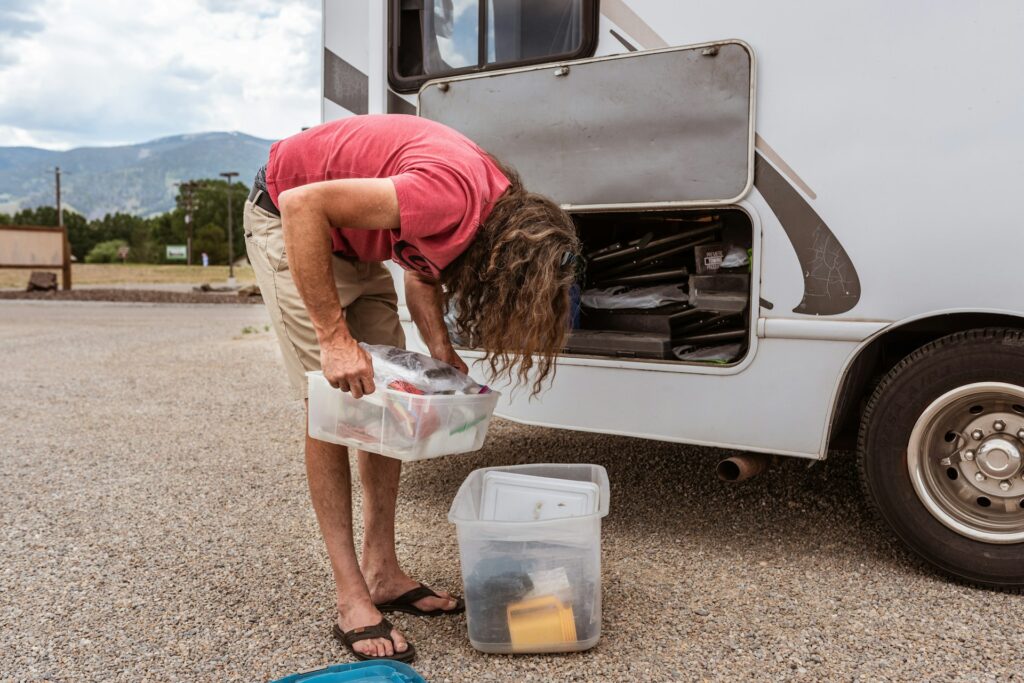
Packing the right types of food for your cabin or cottage camping trip is crucial for maintaining energy levels and enjoying your meals. Here are some categories and examples to consider:
Fresh Foods
- Fruits and Vegetables: Fresh fruit like apples, oranges, and berries are great for snacking and adding to meals. Vegetables such as carrots, bell peppers, and leafy greens can be used in salads and cooked dishes.
- Dairy Products: Cheese, cream cheese, and yogurt are nutritious and versatile. Just ensure they are stored properly in a cooler with reusable ice packs.
Dry Foods
- Grains and Pasta: Bring along rice, quinoa, and pasta. These dry ingredients take up less room and can be used in a variety of meals.
- Granola Bars and Snacks: Easy-access snacks like granola bars, nuts, and dried fruit are perfect for quick energy boosts.
Non-Perishable Foods
- Canned Goods: Hearty soups, beans, and vegetables in cans are convenient and have a long shelf life.
- Peanut Butter and Nut Spreads: These are excellent sources of protein and healthy fats that don’t require refrigeration.
Dehydrated Meals
- Instant Meals: Dehydrated meals and instant soups are lightweight and space-saving, making them great for longer trips. They are also a good way to ensure you have a variety of food without needing much space.
Make-Ahead Meals
- Foil Packet Meals: Prepare meals at home by wrapping ingredients in aluminum foil. These can be cooked over an open fire or camp stove.
- Mason Jar Salads: Layer salads in mason jars for an easy way to pack nutritious meals.
Packaged Foods
- Bread and Tortillas: Flour tortillas and bread are staples that can be used for sandwiches, wraps, and more.
- Packaged Snacks: Trader Joe’s has a variety of food items that are ideal for camping, such as packaged nuts, trail mix, and dried fruit.
Beverage Essentials
- Coffee and Tea: Instant coffee and tea bags are easy to pack and make. They provide a comforting start to your morning in the great outdoors.
- Water and Drinks: Don’t forget to bring enough water bottles and perhaps some drink mixes for added flavor.
Including a mix of these food types ensures that your cabin or cottage camping trip meal plan is well-rounded and satisfying. Variety is key to keeping meals interesting and enjoyable.
How to Ensure Food Safety While Cabin or Cottage Camping?
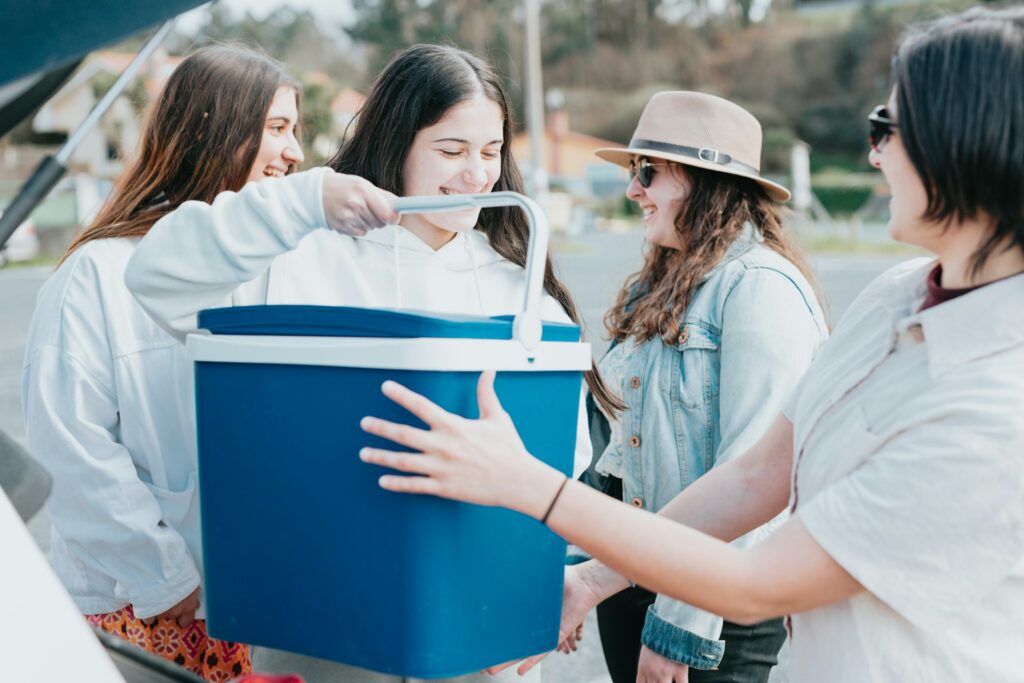
Food safety is crucial when camping, as improper handling and storage can lead to foodborne illnesses. Here are some tips to help you keep your food safe:
Proper Temperature Control
- Coolers and Ice Packs: High-quality coolers and reusable ice packs are used to keep perishable items cold. A cool box is also a great option for maintaining a consistent temperature.
- Separate Coolers: Use separate coolers for raw meat and other perishable foods to avoid cross-contamination. Keeping a cooler for drinks can also help reduce the number of times you open the food cooler, maintaining its temperature longer.
Handling Perishable Foods
- Raw Meat: Store raw meat in airtight containers or zip-top bags to prevent leaks. Keep it at the bottom of the cooler to avoid contamination with other foods.
- Direct Sunlight: Keep coolers and perishable food out of direct sunlight. Store them in a shaded area or cover them with a blanket to insulate against heat.
Safe Storage Practices
- Airtight Containers: Store food in airtight containers. This helps keep out moisture and pests, maintaining the food’s freshness.
- Plastic Bags: Zip-top bags are excellent for organizing and storing food items. They are also useful for marinating meats before cooking.
- Reusable Containers: Invest in durable, reusable containers for storing leftovers and other food items. They are environmentally friendly and keep your food safe.
Cleanliness and Hygiene
- Hand Sanitizer: Keep hand sanitizer readily available before handling food, especially if water for washing hands is limited.
- Cleaning Supplies: Bring biodegradable soap, sponges, and dish towels to clean dishes and cooking utensils. Ensure all surfaces and utensils are clean before preparing food.
Avoiding Cross-Contamination
- Separate Cutting Boards: Use separate cutting boards for raw meat and other foods to prevent the spread of harmful bacteria.
- Food Storage: Store foods that need to be cooked separately from those that will be eaten raw. This helps avoid cross-contamination and keeps your meals safe.
Maintaining Food Temperature
- Cold Sources: Keep cold sources like ice packs and ice blocks in your cooler. Replace them as needed to maintain the right temperature.
- Ice Melt Management: Drain excess water from your cooler regularly to prevent it from reducing the cooler’s efficiency. Cooler water can be reused to keep the interior cold.
Emergency Preparedness
- Backup Food Options: Have non-perishable food options if your perishable food spoils. Canned goods, granola bars, and dehydrated meals are good backups.
- First Aid Kit: Include a basic kit with items like anti-diarrheal medication in case of food-related illness.
Following these food safety tips can significantly reduce the risk of foodborne illnesses during your cabin or cottage camping trip. Proper handling and storage ensure that your meals are delicious and safe to eat, allowing you to enjoy your time outdoors without worry.
What Are the Best Ways to Pack and Store Food for Cabin or Cottage Camping?
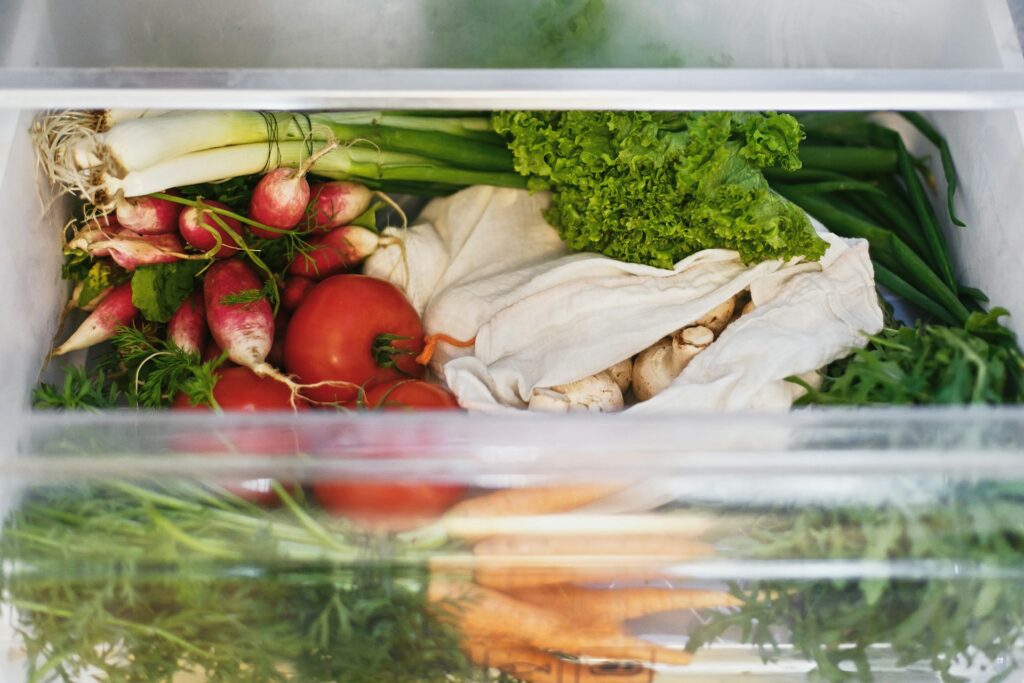
Packing and storing food efficiently is key to a successful cabin or cottage camping trip. Poor food safety can ruin a trip. Here are some best practices to help you pack food in a way that maximizes space, keeps food fresh, and ensures easy access:
Storage Methods
- Airtight Containers: Store dry goods and leftovers in airtight containers. They keep out moisture and pests, maintaining the food’s quality.
- Zip-Top Bags: These are great for storing smaller items and organizing ingredients. They are also useful for marinating meats and can be packed flat to save space.
- Dry Boxes: Dry boxes are excellent for storing non-perishable foods and keeping them safe from moisture. They are particularly useful for pasta, rice, and canned goods.
- Aluminum Foil: Wrap foods in aluminum foil for easy cooking and storage. Foil packets are ideal for make-ahead meals cooked over an open fire or camp stove.
Cooler Tips
- Cooler Water Management: Keep your cooler dry by using reusable ice packs instead of loose ice. If using ice, drain the excess water regularly to maintain the cooler’s efficiency.
- Ice Melt Prevention: Use block ice or frozen water bottles, which melt more slowly than ice cubes. This helps keep the cooler cold for a longer time.
- Organizing for Easy Access: Pack the cooler with frequently used items on top and lesser-used items at the bottom. This reduces the need to open the cooler often, maintaining its internal temperature.
Space-Saving Strategies
- Dry Ingredients and Dry Goods: Pack dry ingredients like flour, sugar, and spices in small, labeled containers. These items take up less room and are essential for cooking.
- Minimize Packaging: Remove excess packaging from food items before packing. This saves space and reduces the waste you must manage during your trip.
- Use Reusable Containers: Pack food in stackable, reusable containers to maximize space in your cooler and storage areas.
Packing for Different Trip Lengths
- Longer Trips: Focus on packing a mix of perishable and non-perishable foods for longer stays. Ensure you have enough food to last the entire trip, and consider backup options like dehydrated meals.
- Weekend Trips: For shorter trips, pack more perishable items and fresh foods that can be consumed quickly. This allows you to enjoy fresher meals without worrying about spoilage.
Efficient Packing Tips
- First-Day Meals: Pack meals for the first day in an easily accessible location. Use your fresh food first. This allows you to quickly prepare your first meal without unpacking everything.
- Second Night Planning: Plan for meals on the second night that require minimal preparation. Leftovers from the first day or simple meals like pasta with pre-made sauces can save time and effort.
Managing Cooler Space
- Layering: Pack your cooler in layers, with heavier items at the bottom and lighter, more frequently used items on top. This prevents squishing and makes it easier to find what you need.
- Cold Sources: Place ice packs or frozen water bottles throughout the cooler to maintain even cooling. This helps keep all items at a safe temperature.
Special Considerations
- Dietary Needs: Ensure you pack enough food to meet dietary restrictions or preferences, such as gluten-free, vegetarian, or other specific diets.
- Backup Food Options: Always have some non-perishable, easy-to-prepare food items as backups. These can be lifesavers if your main food supply runs low or spoils.
Following these packing and storage tips, you can efficiently manage your food supply, keep it fresh, and ensure that your meals are easy to prepare and enjoy during your cabin or cottage camping trip. Proper organization and storage are key to making the most of your culinary adventures in the great outdoors.
How to Prepare Food for a Cabin or Cottage Camping Trip?
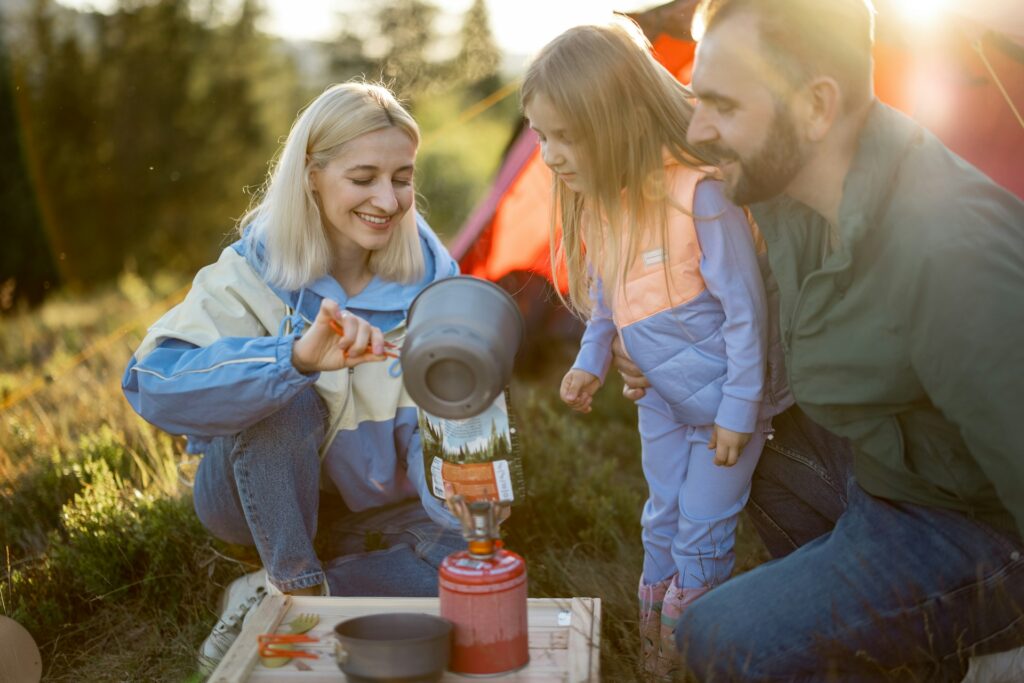
Preparing food before you head out for your cabin or cottage camping trip can save you a lot of time and effort. If it’s just a romantic cabin getaway, meal preparation can be simple. However, family affairs can involve more planning. Here are some tips for prepping meals and making sure you’re ready to cook delicious meals in the great outdoors:
Make-Ahead Meals
- Foil Packet Meals: These are perfect for camping. Prepare your ingredients at home, wrap them in aluminum foil, and store them in your cooler. At the campsite, just place the packets over a campfire or on a camp stove for an easy, no-mess meal.
- Mason Jar Salads: Layer salads in mason jars with the dressing at the bottom and greens at the top. This keeps the salad fresh and prevents sogginess. They’re easy to pack and make a nutritious meal.
- Pancake Mix: Pre-mix your pancake batter at home and store it in a squeeze bottle or zip-top bag. This makes for a quick and easy breakfast option.
Easy Meal Prep Ideas
- Chop and Store: Pre-chop vegetables and store them in airtight containers. This saves prep time and makes it easy to add veggies to any meal.
- Marinate Meats: Marinate meats at home and store them in zip-top bags. This not only adds flavor but also makes them ready to cook as soon as you arrive at the campsite.
- Pre-Cooked Ingredients: Cook ingredients like rice, pasta, and quinoa at home. These can be reheated and used in various dishes, saving you cooking time at the cabin.
Pack Cooking Essentials
- Camp Stove and Fuel: Ensure you have a reliable camp stove and enough fuel. Single burner butane stoves are compact and efficient for camping trips.
- Dutch Oven: A versatile cooking tool, a Dutch oven can be used to bake, stew, and roast over an open fire.
- Cooking Utensils: Bring essential utensils like a can opener, spatula, tongs, and a good knife. Don’t forget a water bottle for hydration while you cook.
Simple Meals for the Campsite
- Hearty Soups: Prepare and freeze hearty soups at home. These can be reheated over a campfire or stove, providing a warm and satisfying meal.
- Grilled Hot Dogs: A classic camping food, hot dogs are easy to cook over an open fire. Add some buns and condiments, and you have a simple and delicious meal.
- Smoky Beans: Canned beans can be jazzed with spices and cooked in a pot over the fire. They make a great side dish or main course.
Meal Planning for the Trip
- First Day Meals: Plan meals for the first day that require minimal preparation. This helps you settle in without the stress of cooking.
- Second Night Dinners: Plan easy-to-prepare meals for the second night, such as pasta with pre-made sauces or foil-packed meals.
- Breakfast Options: Keep breakfast simple with granola bars, instant coffee, and pre-mixed pancake batter. These are quick to prepare and give you energy for the day ahead.
Cooking Over an Open Fire
- Fire Safety: Ensure you follow all fire safety guidelines and regulations for the area you’re camping in. Keep a bucket of water or sand nearby to extinguish the fire if needed.
- Cooking Techniques: Use a grill grate or a Dutch oven for cooking over an open fire. Foil packet meals are also great for this method.
- Temperature Control: Manage the fire’s heat by adjusting the placement of coals or wood. This helps in cooking food evenly and prevents burning.
Storage and Cleanup
- Reusable Containers: Store leftovers in reusable containers to minimize waste and keep your food fresh.
- Biodegradable Soap: Bring biodegradable soap and sponges to wash dishes. This is environmentally friendly and helps keep your campsite clean.
- Trash Management: Plan for waste disposal by bringing trash bags and a system for separating recyclables. Always pack out what you pack in.
By preparing your food ahead of time and bringing the right tools, you can make your cabin or cottage camping trip enjoyable and stress-free. These tips ensure you have delicious meals ready to cook, allowing you to relax and enjoy the great outdoors more.
What Are Some Great Meal Ideas for Cabin or Cottage Camping?
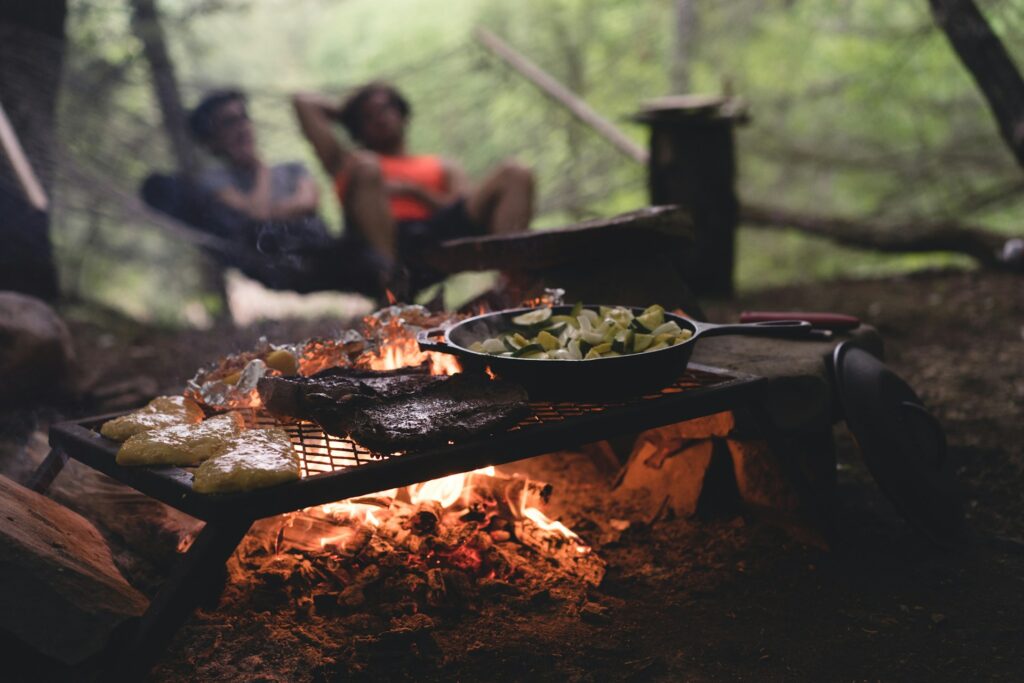
Having a variety of meal ideas ready can make your cabin or cottage camping trip both enjoyable and delicious. Here are some suggestions for breakfast, lunch, dinner, and snacks that are easy to prepare and perfect for the great outdoors:
Breakfast Ideas
- Pancakes and Bacon: Use your pre-mixed pancake batter and cook up some bacon for a hearty breakfast. You can cook both on a camp stove or over a fire with a cast iron skillet.
- Oatmeal with Toppings: Instant oatmeal is a quick and nutritious option. Pack a variety of toppings such as fresh fruit, nuts, and peanut butter to customize your breakfast.
- Breakfast Burritos: Prepare these with scrambled eggs, cheese, and your choice of fillings. Wrap them in foil and heat them up over the campfire for a warm and satisfying meal.
Lunch Ideas
- Sandwiches and Wraps: Use flour tortillas or bread to make sandwiches and wraps with your favorite fillings. Cream cheese and smoked salmon, peanut butter and jelly, or deli meats and cheese are all great options.
- Cold Pasta Salad: Prepare a pasta salad at home with pasta, vegetables, cheese, and a simple vinaigrette. Store it in an airtight container for an easy, no-cook lunch.
- Foil Packet Nachos: Layer tortilla chips, cheese, beans, and your favorite toppings in a foil packet. Heat over the fire until the cheese melts for a fun and tasty meal.
Dinner Ideas
- Grilled Chicken and Vegetables: Marinate chicken breasts and pack them with various pre-chopped vegetables. Grill them over an open fire or cook on a camp stove for a nutritious meal.
- Campfire Chili: Prepare chili at home and freeze it. Reheat it over the campfire for a warm, hearty dinner. Serve with some bread or crackers.
- Dutch Oven Lasagna: Layer cooked lasagna noodles, sauce, cheese, and any additional fillings in a Dutch oven and cook over the fire for a delicious, one-pot meal.
Snack Ideas
- Trail Mix: Make your trail mix with nuts, dried fruit, chocolate chips, and granola. It’s a great way to get an energy boost throughout the day.
- Fresh Fruit and Nut Butter: Apples or bananas with peanut butter make for a healthy and satisfying snack.
- Granola Bars and Protein Bars: These are easy to pack and perfect for a quick snack between meals.
Dessert Ideas
- S’mores: A camping classic, s’mores require only graham crackers, chocolate bars, and marshmallows. Roast the marshmallows over the fire and assemble your s’mores for a sweet treat.
- Dutch Oven Cobbler: Prepare a cobbler with canned fruit and cake mix in a Dutch oven. Cook it over the fire for a warm, delicious dessert.
- Campfire Banana Boats: Slice a banana lengthwise, stuff it with chocolate chips and mini marshmallows, wrap it in foil, and heat it over the fire until everything is melted.
Special Considerations for Meal Planning
- Dietary Needs: When planning your meals, consider any dietary restrictions or preferences. Bring gluten-free options, vegetarian meals, or other necessary foods to accommodate everyone in your group.
- Easy Cleanup: Plan meals that require minimal cleanup. Foil packet meals, one-pot dishes, and pre-made salads can all save you a lot of time and effort.
- Cooking Instructions: Make sure you have all necessary cooking instructions and tools packed. A portable camp stove, Dutch oven, and basic utensils like a can opener and spatula are essential.
By having a variety of meal ideas prepared, you can enjoy delicious and nutritious meals throughout your cabin or cottage camping trip. These ideas ensure that you have options for every meal and snack, making your camping experience more enjoyable and stress-free.
How to Make a Camping Food List?

Creating a comprehensive camping food list is essential for ensuring you have everything you need for your cabin or cottage camping trip. Here’s how to make a thorough and organized food list:
Categorize Your Food
- Perishables: List items that need refrigeration, such as meats, dairy products, and fresh produce.
- Non-Perishables: Include canned goods, pasta, rice, and other items that don’t require refrigeration.
- Snacks: Add granola bars, nuts, dried fruit, and other snacks that are easy to grab and eat.
- Beverages: Don’t forget water, instant coffee, tea, and any other drinks you enjoy.
- Condiments and Spices: Include olive oil, salt, pepper, and any other seasonings or sauces you’ll need for cooking.
Plan by Meals
- Breakfast: List ingredients for planned breakfasts, such as pancake mix, oatmeal, and eggs.
- Lunch: Include items for sandwiches, wraps, salads, and any other planned lunches.
- Dinner: List ingredients for each dinner, such as meats, vegetables, pasta sauces, and side dishes.
- Snacks: Ensure you have a variety of snacks to keep everyone satisfied between meals.
- Desserts: Include ingredients for s’mores, campfire banana boats, or other sweet treats.
Essentials and Extras
- Cooking Supplies: Include camp stove, fuel, Dutch oven, and cooking utensils like spatulas, tongs, and can opener.
- Storage Supplies: List reusable containers, zip-top bags, aluminum foil, and dry boxes for food storage.
- Cleaning Supplies: Don’t forget biodegradable soap, sponges, dish towels, and trash bags.
- Emergency Food: Pack extra non-perishable foods as a backup, such as canned goods and dehydrated meals.
Example Camping Food List
- Perishables:
- Chicken breasts
- Bacon
- Eggs
- Fresh fruit (apples, bananas, berries)
- Vegetables (carrots, bell peppers, leafy greens)
- Cheese
- Yogurt
- Milk
- Non-Perishables:
- Rice
- Quinoa
- Pasta
- Canned beans
- Canned vegetables
- Peanut butter
- Bread
- Flour tortillas
- Granola bars
- Nuts and dried fruit
- Instant coffee
- Condiments and Spices:
- Olive oil
- Salt and pepper
- Sugar
- Honey
- Hot sauce
- Salad dressing
- Beverages:
- Water bottles
- Tea bags
- Drink mixes
Checklist
Create a checklist format for easy shopping and packing:
- Chicken breasts
- Bacon
- Eggs
- Fresh fruit
- Vegetables
- Cheese
- Yogurt
- Milk
- Rice
- Quinoa
- Pasta
- Canned beans
- Canned vegetables
- Peanut butter
- Bread
- Flour tortillas
- Granola bars
- Nuts and dried fruit
- Instant coffee
- Olive oil
- Salt and pepper
- Sugar
- Honey
- Hot sauce
- Salad dressing
- Water bottles
- Tea bags
- Drink mixes
A well-organized camping food list ensures you don’t forget anything and helps you plan meals efficiently. See our handy checklist that you can download below.
How to Cook Food While Cabin or Cottage Camping?
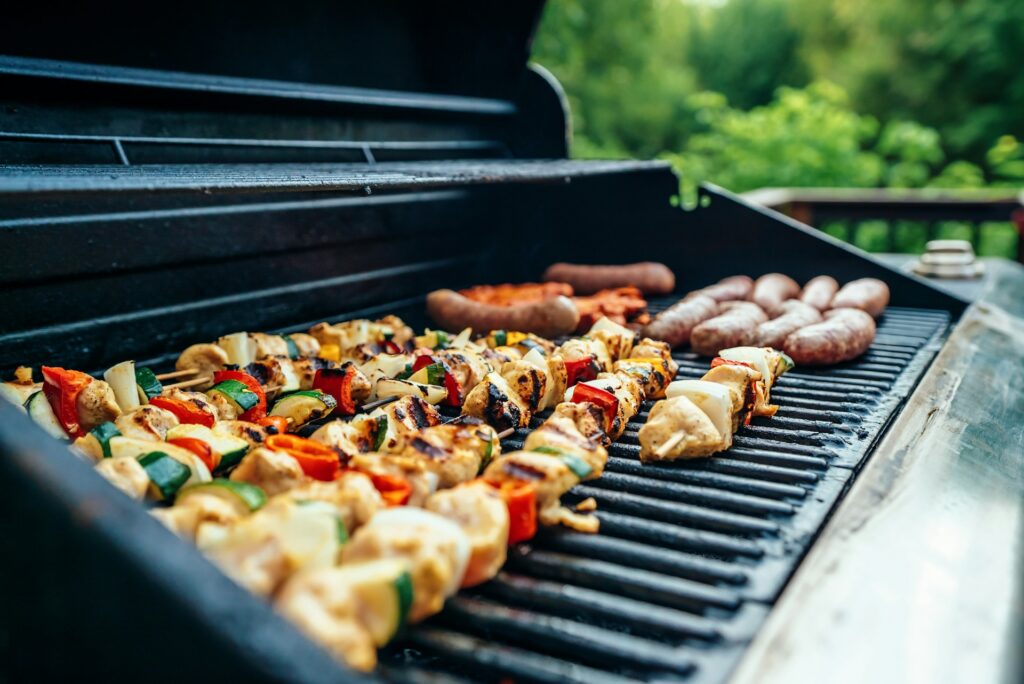
Cooking while cabin or cottage camping can be a delightful experience if you have the right tools and techniques. Here are some tips for cooking delicious meals in the great outdoors:
Essential Cooking Tools
- Camp Stove: A camp stove is a versatile and essential tool for cooking. Single burner butane stoves are compact and efficient.
- Dutch Oven: Perfect for baking, stewing, and roasting over an open fire.
- Grill Grate: Ideal for grilling meats and vegetables over a campfire.
- Portable Grill: Useful for grilling and can be used with charcoal or gas.
- Cooking Utensils: Bring a spatula, tongs, knife, cutting board, and can opener. These basics will cover most of your cooking needs.
Cooking Techniques
- Open Fire Cooking:
- Use a grill grate over the fire for grilling meats and vegetables.
- Foil packet meals can be placed directly on hot coals for even cooking.
- Manage firewood placement to control the heat and prevent burning food.
- Camp Stove Cooking:
- Use a camp stove for boiling water, cooking pasta, or heating soups.
- Single burner stoves are great for quick meals like scrambled eggs or pancakes.
- Dutch Oven Cooking:
- Layer ingredients in the Dutch oven for stews, casseroles, or even baking bread.
- Place the Dutch oven over hot coals and cover with more coals for even heat distribution.
Easy Recipes
- Foil Packet Dinners:
- Combine protein (chicken, beef, fish), vegetables, and seasonings in a foil packet.
- Cook over the campfire for a complete and easy meal.
- One-Pot Pasta:
- Cook pasta, add a pre-made sauce, and mix in cooked vegetables or meat.
- This is a simple and quick dinner option that requires minimal cleanup.
- Grilled Vegetables:
- Slice vegetables like bell peppers, zucchini, and mushrooms.
- Season with olive oil, salt, and pepper, then grill over the fire or on a portable grill.
- Hearty Soups:
- Reheat pre-cooked soups over the camp stove or fire.
- Add fresh herbs or spices to enhance the flavor.
- Pancake Breakfast:
- Use pre-mixed pancake batter and cook on a hot griddle or skillet.
- Serve with fresh fruit, syrup, and bacon for a hearty breakfast.
Tips for Efficient Camp Cooking
- Meal Prep:
- Prepare ingredients ahead of time, such as chopping vegetables and marinating meats.
- Store prepped ingredients in airtight containers or zip-top bags.
- Organize Your Cooking Area:
- Set up a designated cooking area with all your tools and ingredients within reach.
- Use a foldable table if available to keep things organized and clean.
- Clean as You Go:
- Keep your cooking area clean by washing dishes and utensils as you use them.
- Use biodegradable soap and ensure all food scraps are disposed of properly.
- Safety First:
- Always follow fire safety guidelines and keep a bucket of water or sand nearby.
- Be cautious with camp stoves and open flames to prevent accidents.
By using these tips and techniques, you can enjoy cooking delicious and varied meals during cabin or cottage camping. Proper preparation and the right tools make outdoor cooking both fun and rewarding.
What Are Some Handy Gadgets and Tools for Cabin or Cottage Cooking?
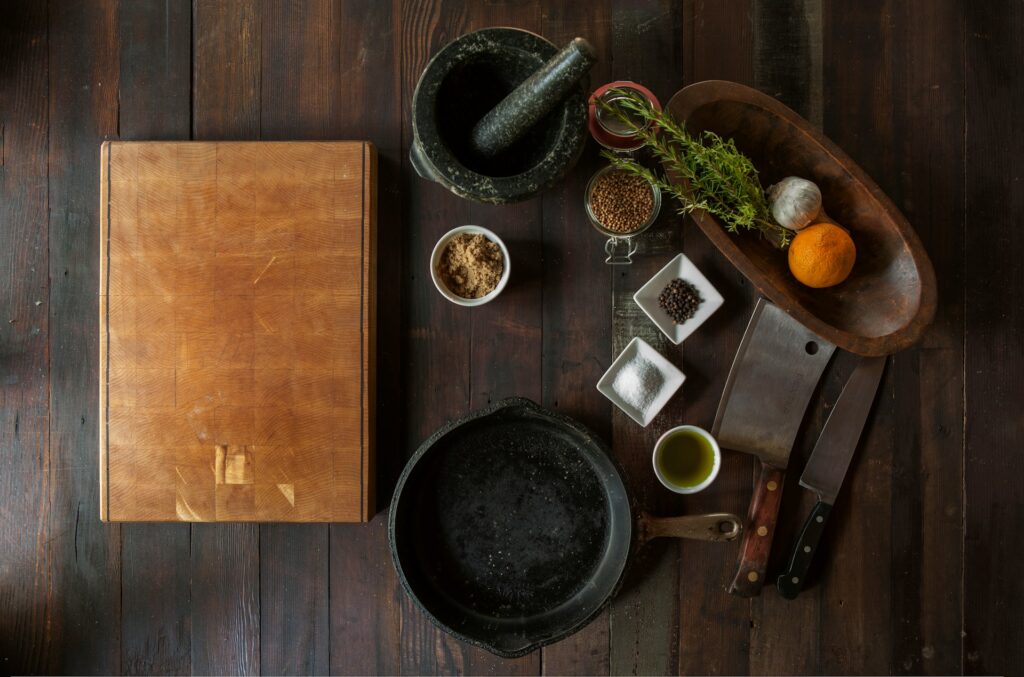
When cooking at a cabin or cottage, having the right gadgets and tools can make all the difference. Essential tools such as a camp stove, can opener, water bottle, and hand sanitizer are must-haves for any outdoor cooking adventure. A camp stove is a portable and convenient way to cook meals, while a can opener is necessary for opening canned goods. A water bottle is essential for staying hydrated, and hand sanitizer is crucial for maintaining cleanliness and hygiene.
In addition to these essential tools, several items can make camp cooking easier and more enjoyable. For instance, a paper bag can be used to collect kindling for a campfire, while a zip-top bag can help with organizing and storing ingredients. Aluminum foil is a versatile tool for cooking, as it can be used to wrap food for grilling or baking and to store leftovers.
Other handy gadgets and tools for cabin or cottage cooking include a portable grill, a cast-iron skillet, and a Dutch oven. A portable grill is perfect for cooking burgers, hot dogs, and other grilled favorites, while a cast-iron skillet is ideal for frying up bacon, eggs, and pancakes. A Dutch oven is a versatile tool that can be used for baking, roasting, and stewing, making it a valuable addition to any outdoor kitchen.
Overall, having the right gadgets and tools can make cabin or cottage cooking a breeze. Whether you’re a seasoned outdoor chef or a novice cook, these essential tools and handy items will help you create delicious meals in the great outdoors.
Final Thoughts About How to Pack Food for Cabin Camping
As you prepare for your cabin camping trip, it’s important to carefully consider how to pack your food. It’s essential to pack items that are non-perishable, easy to prepare, and require minimal cooking equipment. Make sure to pack enough food for the duration of your trip, taking into consideration any outdoor activities that may increase your appetite. Utilize airtight containers and coolers to keep your food fresh and safe from wildlife. Remember to pack out any trash and leftovers to leave the cabin and surrounding area clean for the next campers. With a little bit of planning and preparation, you can enjoy delicious and satisfying meals during your cabin camping adventure.

